
(a)
Interpretation:
When the given compound is heated, ethene gas is evolved and a product with the formula
Concept introduction:
The Diels-Alder reaction is reversible at high temperature, and this process is called a retro Diels-Alder reaction. The mechanism for this reaction is as the reverse of a Diels-Alder mechanism i.e. the entire six-membered ring is break-down into the corresponding diene and the dienophile. The aromatic proton given signal range from
Answer to Problem 24.82P
The structure of
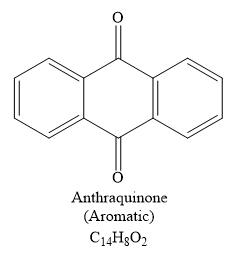
Explanation of Solution
The given compound is
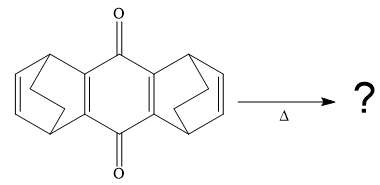
So when this compound is heated, ethene gas is evolved and a product with formula
The signal in
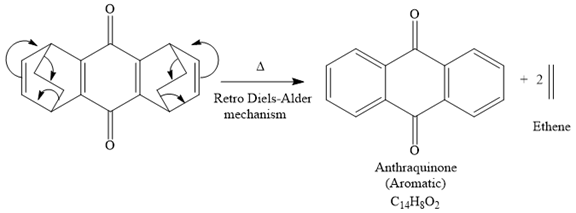
The product of the retro Diels-Alder reaction is also aromatic and matched with the given spectra and also ethene gas is evolved. so the above product is the correct one.
When the given compound is heated, ethene gas is evolved and a product with the formula
(b)
Interpretation:
When the given compound is heated, ethene gas is evolved and a product with the formula
Concept introduction:
The Diels-Alder reaction is reversible at high temperature and this process is called a retro Diels-Alder reaction. The mechanism for this reaction is as the reverse of a Diels-Alder mechanism i.e. the entire six-membered ring is broken down into the corresponding diene and the dienophile. The aromatic proton given signal range from
Answer to Problem 24.82P
The mechanism for the given reaction is

Explanation of Solution
The given compound is

So when this compound is heated, ethene gas is evolved and product with formula
The signal in
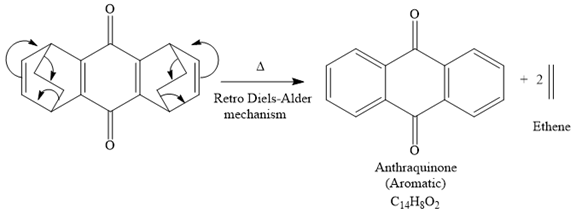
The product of the retro Diels-Alder reaction is also aromatic and matched with the given spectra and also ethene gas is evolved. So the above product and the mechanism (retro Diels-Alder mechanism) is the correct one.
When the given compound is heated, ethene gas is evolved and a product with the formula
(c)
Interpretation:
When the given compound is heated, ethene gas is evolved and a product with the formula
Concept introduction:
The Diels-Alder reaction is reversible at high temperature and this process is called a retro Diels-Alder reaction. The mechanism for this reaction is as the reverse of a Diels-Alder mechanism i.e. the entire six-membered ring is break-down into the corresponding diene and the dienophile. The aromatic proton given signal range from
Answer to Problem 24.82P
The main driving force that favours the product in the given reaction is the formation of a more stable aromatic compound.
Explanation of Solution
The given reaction is
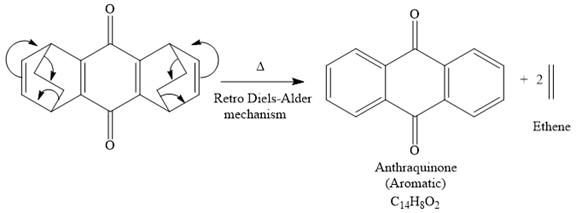
It is noticed that the starting material in the given reaction is overall non-aromatic and also possesses strain due to middle ethylene groups on both sides, but the product is aromatic and strain-free one. Since aromatic compounds are more stable than the non-aromatic compounds this is a key state and the main driving force for the given reaction.
When the given compound is heated, ethene gas is evolved and a product with the formula
Want to see more full solutions like this?
Chapter 24 Solutions
Organic Chemistry: Principles And Mechanisms
- For Raman spectroscopy/imaging, which statement is not true regarding its disadvantages? a) Limited spatial resolution. b) Short integration time. c) A one-dimensional technique. d) Weak signal, only 1 in 108 incident photons is Raman scattered. e) Fluorescence interference.arrow_forwardUsing a cell of known pathlength b = 1.25115 x 10-3 cm, a water absorption spectrum was measured. The band at 1645 cm-1, assigned to the O-H bending, showed an absorbance, A, of 1.40. a) Assuming that water density is 1.00 g/mL, calculate the water molar concentration c (hint: M= mole/L) b) Calculate the molar absorptivity, a, of the 1645 cm-1 band c) The transmitted light, I, can be written as I= Ioexp(-xb), where x is the absorption coefficient (sometimes designated as alpha), Io is the input light, and b is the cell pathlength. Prove that x= (ln10)*x*c. (Please provide a full derivation of the equation for x from the equation for I). d) Calculate x for the 1645 cm-1 bandarrow_forwardI need help with the follloaingarrow_forward
- For a CARS experiment on a Raman band 918 cm-1, if omega1= 1280 nm, calculate the omega2 in wavelength (nm) and the CARS output in wavelength (nm).arrow_forwardI need help with the following questionarrow_forwardFor CARS, which statement is not true regarding its advantages? a) Contrast signal based on vibrational characteristics, no need for fluorescent tagging. b) Stronger signals than spontaneous Raman. c) Suffers from fluorescence interference, because CARS signal is at high frequency. d) Faster, more efficient imaging for real-time analysis. e) Higher resolution than spontaneous Raman microscopy.arrow_forward
- Draw the major product of the Claisen condensation reaction between two molecules of this ester. Ignore inorganic byproducts. Incorrect, 5 attempts remaining 1. NaOCH3/CH3OH 2. Acidic workup Select to Draw O Incorrect, 5 attempts remaining The total number of carbons in the parent chain is incorrect. Review the reaction conditions including starting materials and/or intermediate structures and recount the number of carbon atoms in the parent chain of your structure. OKarrow_forwardUsing a cell of known pathlength b = 1.25115 x 10-3 cm, a water absorption spectrum was measured. The band at 1645 cm-1, assigned to the O-H bending, showed an absorbance, A, of 1.40. a) Assuming that water density is 1.00 g/mL, calculate the water molar concentration c (hint: M= mole/L) b) Calculate the molar absorptivity, a, of the 1645 cm-1 band c) The transmitted light, I, can be written as I= Ioexp(-xb), where x is the absorption coefficient (sometimes designated as alpha), Io is the input light, and b is the cell pathlength. Prove that x= (ln10)*x*c d) Calculate x for the 1645 cm-1 bandarrow_forwardConvert 1.38 eV into wavelength (nm) and wavenumber (cm-1) (c = 2.998 x 108 m/s; h = 6.626 x 10-34 J*s).arrow_forward
 ChemistryChemistryISBN:9781305957404Author:Steven S. Zumdahl, Susan A. Zumdahl, Donald J. DeCostePublisher:Cengage Learning
ChemistryChemistryISBN:9781305957404Author:Steven S. Zumdahl, Susan A. Zumdahl, Donald J. DeCostePublisher:Cengage Learning ChemistryChemistryISBN:9781259911156Author:Raymond Chang Dr., Jason Overby ProfessorPublisher:McGraw-Hill Education
ChemistryChemistryISBN:9781259911156Author:Raymond Chang Dr., Jason Overby ProfessorPublisher:McGraw-Hill Education Principles of Instrumental AnalysisChemistryISBN:9781305577213Author:Douglas A. Skoog, F. James Holler, Stanley R. CrouchPublisher:Cengage Learning
Principles of Instrumental AnalysisChemistryISBN:9781305577213Author:Douglas A. Skoog, F. James Holler, Stanley R. CrouchPublisher:Cengage Learning Organic ChemistryChemistryISBN:9780078021558Author:Janice Gorzynski Smith Dr.Publisher:McGraw-Hill Education
Organic ChemistryChemistryISBN:9780078021558Author:Janice Gorzynski Smith Dr.Publisher:McGraw-Hill Education Chemistry: Principles and ReactionsChemistryISBN:9781305079373Author:William L. Masterton, Cecile N. HurleyPublisher:Cengage Learning
Chemistry: Principles and ReactionsChemistryISBN:9781305079373Author:William L. Masterton, Cecile N. HurleyPublisher:Cengage Learning Elementary Principles of Chemical Processes, Bind...ChemistryISBN:9781118431221Author:Richard M. Felder, Ronald W. Rousseau, Lisa G. BullardPublisher:WILEY
Elementary Principles of Chemical Processes, Bind...ChemistryISBN:9781118431221Author:Richard M. Felder, Ronald W. Rousseau, Lisa G. BullardPublisher:WILEY





